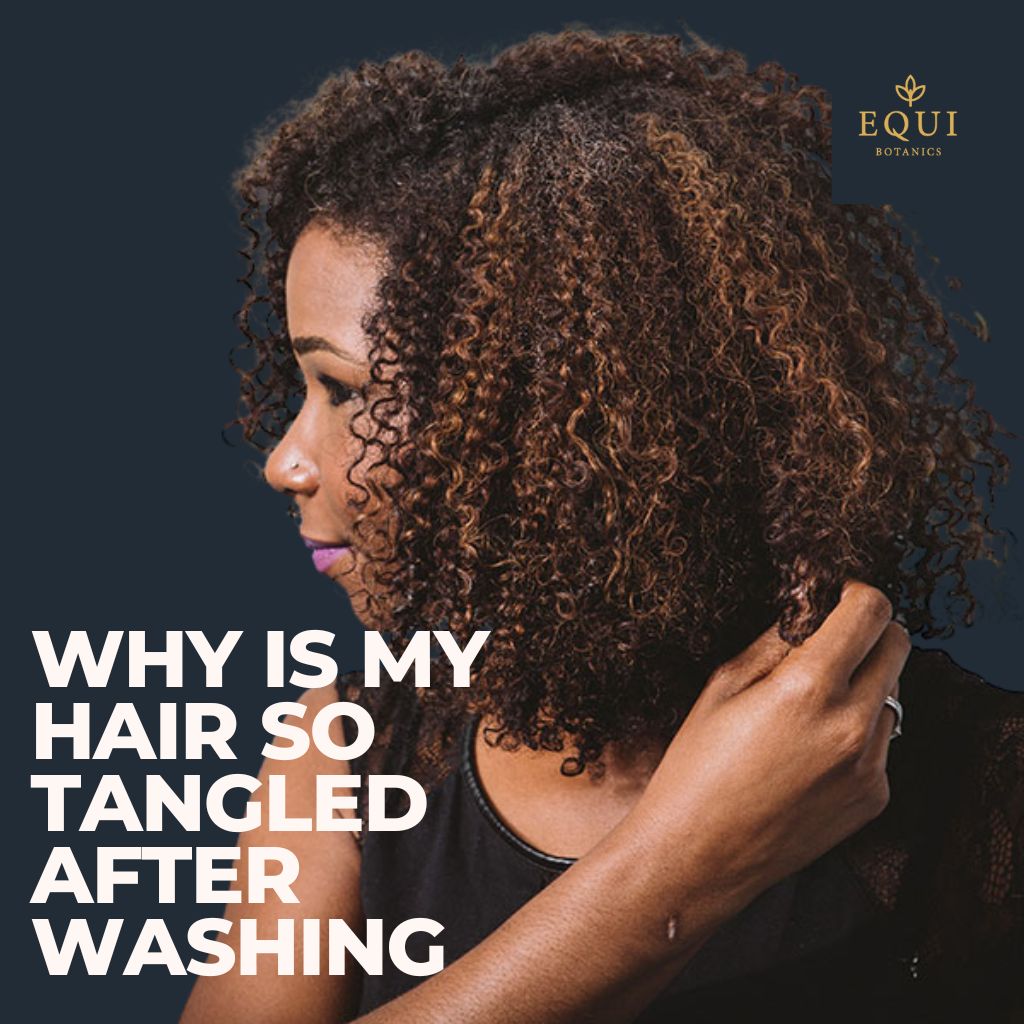
Whatever your hair type, from afro to straight, fine to frizzy, we’ve all experienced tangled hair at some stage. It can be highly frustrating when your freshly washed locks don’t allow your brush to glide right through your tresses.
The main cause of the problem is dehydration. Keeping your locks super hydrated is essential to keeping them tangle-free but of course, that isn’t the only factor to consider.
Causes of tangled hair after washing

Before learning how to treat and prevent tangled hair, it’s imperative to drill down to the root cause of any knots and matting you may be experiencing. The most common reasons hair is prone to tangles are as follows:
- Dry, dehydrated, or damaged hair
- Not thoroughly rinsing
- Lack of brushing
- Towel drying hair
- Ill-suited hair products
- Heat styling and exposure
- Hard water
- Thick, frizz-prone or curly hair
- Long, fine hair
1. Dehydration
Most hair complaints come back to dehydration, so it’s no surprise this is top of the list of tangled hair causes. A great way to treat dry locks is to regularly apply a hair treatment such as a Babassu Oil Hair Masque as well as applying a hair oil post-wash.
2. Not thoroughly rinsing
Rinsing hair products is a highly important step in the hair washing process. Product left in can lead to hair becoming matted, but also weighs down your tresses meaning tangles are more common.
3. Hair Type
There are several hair types more susceptible to tangling after a wash and in general. Surprisingly fine hair is one of those, particularly if it is longer. Fine hair has thinner strands, and more of them, which means the chance of tangling increases. In general, longer hair is more likely to knot, however, thick, frizz-prone, and curly hair is also more at risk because it is likely to have a dry texture.

Why is blonde hair so tangled after washing? Blonde hair is typically more at risk of tangling after washing, as it is naturally more porous and the same applies for colour treated blonde hair, so anything that comes into contact with your luscious, blonde locks will possibly make it more dry and brittle.
4. Washing hair incorrectly
Washing hair isn’t as simple a process as you might think, wash too little and you are left with build-up, wash too much and you may be stripping hair of its natural oils.
Not only that but if you are using products that aren’t suited to your hair type and texture or those that contain chemicals such as sulphates, then this can further dry out your hair leading to a tangled mess.
5. Towel drying hair
 One of the most common acts after getting out of the shower from washing hair is to rub through with a towel and it is a fatal mistake in the battle against tangles!
One of the most common acts after getting out of the shower from washing hair is to rub through with a towel and it is a fatal mistake in the battle against tangles!
The fibres of a towel tend to be too harsh, causing friction and this rubbing can tangle hair as you dry it. Post shower, have a microfibre towel to hand to gently squeeze excess water out.
6. Shampoo and Conditioner
Using too much product, particularly shampoo, can strip the hair of its natural oils and scalp build up, causing dryness and therefore tangles.
It is also important to note that conditioning should never be skipped as this puts essential moisture back into the hair as well as further protecting it from issues like frizz that can further tangle hair.
7. Heat exposure
Heat styling is often associated with dry hair, as the use of heat tools on your locks can cause them to become dehydrated. However, it’s not just heat tools you need should avoid where possible, unfortunately, the sun can also impact your dry hair! Although, there’s an easy fix… Apply a UV spray over your locks to keep your hair hydrated and safe from the sun’s drying rays.
8. Water temperature and quality
If you are in a hard water area, this will, unfortunately, impact the condition of your hair as hard water contains a damaging build-up of chemicals, so it is highly recommended you use a water softener to avoid drying out your hair, if this applies to your household.
Not only can water hardness impact the quality of your hair, but so can the temperature. It is already common knowledge that heat styling can cause dehydrated locks but so too can scalding hot water. Heat strips the scalp of oil which can lead to frizz and tangles.
9. Brushing
Failing to brush daily is going to leave you more open to the risk of tangles and matting. Daily brushing ensures you keep locks free from sweat and oil build up as well as catching any knots early before they become a more serious problem to tackle.
Ultimately, knots that are brushed out before washing, mean your hair is less likely to become tangled once you step out of the shower.
4 easy steps on how to get rid of tangled hair after a shower?
So we’ve got to the bottom of what causes hair to mat and tangle after washing but now it is time to rid you of your post-shower tangles for good! Follow our step by step to achieve tangle free tresses in an instant!
1. Shampoo
Start the detangling process from the moment you step into the shower by using a small amount of a detangling shampoo. Using a targeted product, such as this cleanser, which has been formulated to detangle hair as well as thoroughly cleanse it without stripping, will ensure that your hair is clean whilst being left soft and knot free!
2. Conditioner
Follow shampooing, by applying a deep moisturising conditioner to the lengths and ends of hair, gently run fingers through the hair to loosen and free any tangles that may be forming.
3. Squeeze dry and comb hair
Using a microfibre towel, gently squeeze water out from to end and repeat until excess water is removed.
Let your hair dry naturally whenever possible to avoid excessive application of heat from styling tools. This is also a great opportunity to brush through your tresses.
Generally, it isn’t advised to brush through whilst hair is wet as this is when it is at its most fragile. However, with a specific brush for wet hair or a wide toothed comb, and a delicate brushing technique, this is an important step for those looking to get rid of tangled hair after showering.
4. Hair treatments
A great way to counteract dry, brittle locks is by using hair treatments. From hydrating masks to nourishing oils, you can be sure that consistent application of these products will keep your hair from feeling dry and go some way to preventing tangles.
Black Seed Hair Oil is a great, multi-purpose product that doubles up as a treatment mask as well as a nurturing hair oil. Once hair has been brushed through, apply 1-2 pumps of this through the lengths of hair to leave hair frizz free and hydrated. Also, topical application of detangling spray is a good idea to counteract tangled tresses!
Frequently Asked Questions
Can tangled hair cause hair loss?
Yes, there is a link between hair loss and tangled locks. Dry hair is more prone to breakages and fall out anyway but with the additional pressure that is put on the follicles through trying to yank out a knot, it is possible to experience more extensive hair loss.
How do I prevent tangles in between washes?
Daily brushing is the best solution to avoid tangled hair but also keep a detangling spray to hand to help brushes gently glide through your locks when a knot is encountered. Application of an oil to dry hair throughout the week will also keep hair hydrated to reduce the risk of knots. You can also think about switching your cotton pillowcase out for a silk one to keep on top of tangles whilst you sleep.
Takeaway
Like so many other hair related obstacles, tangle free locks are reliant on hydration, but be sure to consider other aspects of your hair care life too. Diet, products, types of washing, products and drying techniques are all things you need to be on top of to achieve a knotless life.





